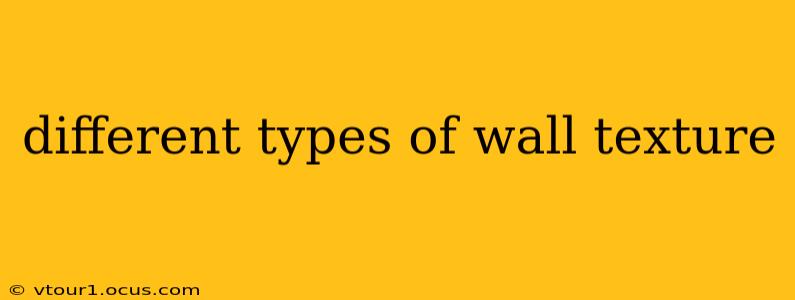Choosing the right wall texture can dramatically impact the look and feel of your home. From subtle elegance to bold statements, the options are vast and varied. This guide explores the different types of wall textures, their applications, and considerations for choosing the perfect finish for your space. We'll cover everything from the most popular choices to those less commonly known, helping you navigate the world of wall finishes with confidence.
What are the Different Types of Wall Textures?
Wall textures are broadly categorized by the finish they create. These range from smooth and sleek to heavily textured and rough. The texture is often determined by the application method and the materials used. Let's explore some of the most popular options:
1. Smooth Walls
Smooth walls, as the name suggests, have a completely flat surface with minimal texture. This classic finish is ideal for modern and minimalist designs, creating a clean and sophisticated aesthetic. They are easy to clean and maintain, making them a popular choice for high-traffic areas.
Pros: Clean, modern look; easy to clean; versatile. Cons: Can show imperfections; may not be suitable for all design styles.
2. Orange Peel Texture
Orange peel texture, named for its resemblance to the fruit's skin, is a very popular choice for its subtle texture and ease of application. It's achieved using a spray technique, creating a slightly bumpy, uniform surface. This texture is excellent at hiding minor wall imperfections.
Pros: Hides minor imperfections; easy to apply; durable. Cons: Can be difficult to repair; may not be suitable for highly detailed designs.
3. Knockdown Texture
Knockdown texture is similar to orange peel but with a slightly coarser finish. After spraying the material onto the wall, a tool is used to "knock down" the peaks, creating a less pronounced, more even texture. This offers a more pronounced texture than orange peel while still hiding imperfections.
Pros: Hides imperfections; durable; offers a more defined texture than orange peel. Cons: Can be more difficult to apply than orange peel; may require more skill to achieve a consistent finish.
4. Popcorn Texture (Acoustic Texture)
Popcorn texture, also known as acoustic texture, was once extremely popular due to its sound-dampening properties. This heavily textured finish is created by spraying a mixture of water and cellulose fibers onto the wall. However, it's falling out of favor due to concerns about asbestos in older applications.
Pros: Excellent sound absorption; hides wall imperfections. Cons: Difficult to clean; can harbor dust and allergens; asbestos concerns in older homes.
5. Sand Texture
Sand texture offers a slightly rougher finish than orange peel or knockdown. It's created by adding sand to the paint or applying a sand-like material to the wall. This creates a distinct tactile experience and a visually interesting finish.
Pros: Unique look and feel; hides minor imperfections. Cons: Can be difficult to clean; may not be suitable for all design styles.
6. Stipple Texture
Stipple texture is created by applying paint with a stippling brush or roller, resulting in a speckled, slightly bumpy surface. It's a subtle texture that adds visual interest without being overly dramatic.
Pros: Subtle texture; easy to apply; versatile. Cons: May not hide imperfections as effectively as other textures.
7. Venetian Plaster
Venetian plaster is a luxurious and elegant finish that creates a smooth, almost luminous surface. This technique involves applying multiple thin layers of plaster, often with a metallic sheen. It's a high-end option that adds a touch of sophistication to any space.
Pros: Elegant and sophisticated look; durable; easy to clean. Cons: Expensive; requires skilled application.
What are the Pros and Cons of Textured Walls?
Pros of Textured Walls:
- Hide imperfections: Many textured finishes effectively conceal minor wall imperfections.
- Add visual interest: Textures can add depth and dimension to a room.
- Sound absorption: Some textures, like popcorn, offer sound-dampening properties.
- Durability: Textured walls are often more durable and resistant to scratches than smooth walls.
Cons of Textured Walls:
- Difficult to clean: Heavily textured walls can be more challenging to clean than smooth walls.
- Difficult to repair: Repairing damage to textured walls can be more complex and time-consuming.
- May not suit all styles: Some textures may not be appropriate for all interior design styles.
How to Choose the Right Wall Texture for Your Home
The best wall texture for your home depends on your personal preferences, the style of your home, and the specific room. Consider these factors:
- Your design style: A modern minimalist space might benefit from smooth walls, while a rustic home might look better with a more textured finish.
- The room's function: High-traffic areas like hallways might benefit from durable textures that are easy to clean. Bedrooms might benefit from sound-absorbing textures.
- Your budget: Some textures, like Venetian plaster, are more expensive than others.
By carefully considering these factors, you can choose the perfect wall texture to create the atmosphere you desire in your home. Remember to always consult with a professional painter for advice and assistance.
